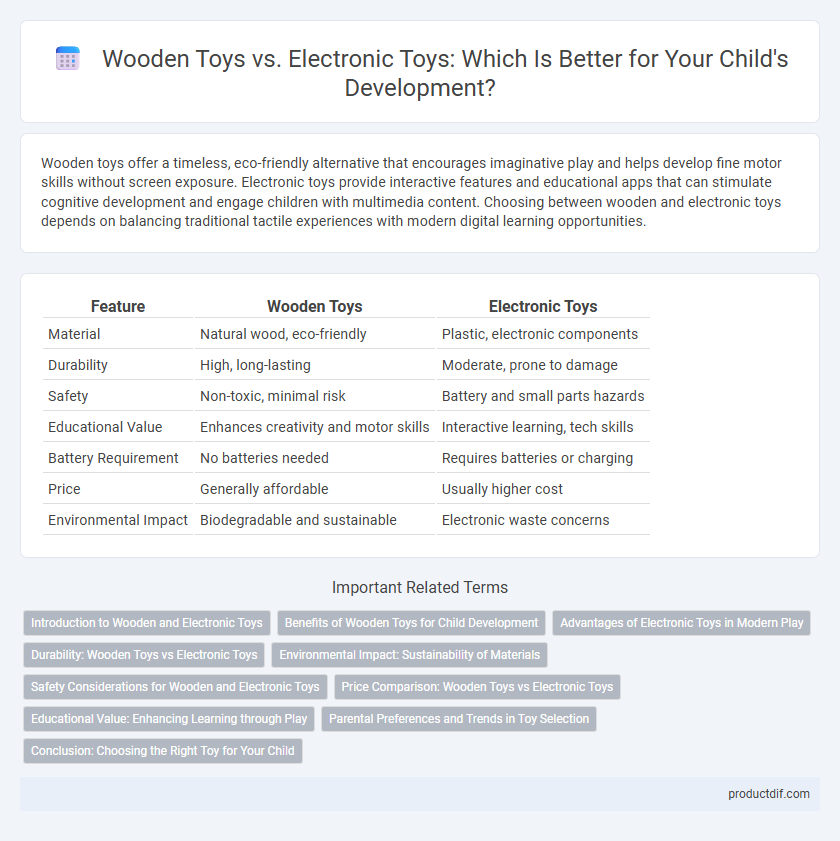Wooden toys offer a timeless, eco-friendly alternative that encourages imaginative play and helps develop fine motor skills without screen exposure. Electronic toys provide interactive features and educational apps that can stimulate cognitive development and engage children with multimedia content. Choosing between wooden and electronic toys depends on balancing traditional tactile experiences with modern digital learning opportunities.
Table of Comparison
| Feature | Wooden Toys | Electronic Toys |
|---|---|---|
| Material | Natural wood, eco-friendly | Plastic, electronic components |
| Durability | High, long-lasting | Moderate, prone to damage |
| Safety | Non-toxic, minimal risk | Battery and small parts hazards |
| Educational Value | Enhances creativity and motor skills | Interactive learning, tech skills |
| Battery Requirement | No batteries needed | Requires batteries or charging |
| Price | Generally affordable | Usually higher cost |
| Environmental Impact | Biodegradable and sustainable | Electronic waste concerns |
Introduction to Wooden and Electronic Toys
Wooden toys offer durable, eco-friendly play options known for promoting creativity and fine motor skills in children. Electronic toys integrate technology to provide interactive experiences, often featuring lights, sounds, and educational content that engage cognitive development. Both types of toys cater to different learning styles and play preferences, blending traditional craftsmanship with modern innovation.
Benefits of Wooden Toys for Child Development
Wooden toys enhance child development by promoting creativity, fine motor skills, and sensory exploration through their natural textures and open-ended design. Unlike electronic toys, wooden toys encourage imaginative play and problem-solving without overstimulation. These eco-friendly, durable toys also support cognitive growth by allowing children to engage deeply with simple, tangible materials.
Advantages of Electronic Toys in Modern Play
Electronic toys enhance cognitive development by integrating interactive features such as lights, sounds, and educational games that stimulate multiple senses simultaneously. These toys often include programmable components and connectivity options, fostering creativity and problem-solving skills through adaptive learning experiences. Their ability to update software ensures ongoing engagement and keeps children aligned with the latest educational content and technological advancements.
Durability: Wooden Toys vs Electronic Toys
Wooden toys typically offer greater durability due to their solid construction and natural materials, resisting wear and tear over years of use. Electronic toys often contain fragile components like batteries and circuits that can malfunction or break, leading to shorter lifespans. Choosing wooden toys ensures long-lasting play value and sustainability compared to many electronic alternatives.
Environmental Impact: Sustainability of Materials
Wooden toys are often made from renewable, biodegradable materials, making them a more sustainable choice compared to electronic toys, which typically contain non-recyclable plastics and electronic components. The production of wooden toys usually involves fewer carbon emissions and less energy consumption than manufacturing electronic toys, contributing to lower environmental impact. Choosing wooden toys supports eco-friendly practices by reducing electronic waste and promoting the use of sustainable forestry resources.
Safety Considerations for Wooden and Electronic Toys
Wooden toys offer enhanced safety due to their natural, non-toxic materials and minimal small parts, reducing choking hazards for young children. Electronic toys, while engaging, often contain batteries and electronic components that pose risks such as overheating, ingestion of small parts, and electrical shocks if not properly designed. Parents should prioritize certification labels like ASTM or EN71, ensuring both wooden and electronic toys comply with rigorous safety standards to protect children during play.
Price Comparison: Wooden Toys vs Electronic Toys
Wooden toys typically cost less upfront compared to electronic toys, primarily due to simpler materials and craftsmanship. Electronic toys involve higher production costs related to technology components, batteries, and software integration. Price differences can influence buying decisions, with wooden toys offering affordable durability while electronic toys provide advanced interactive features.
Educational Value: Enhancing Learning through Play
Wooden toys promote sensory development, fine motor skills, and creativity through open-ended play, fostering deeper cognitive engagement in children. Electronic toys offer interactive features and immediate feedback, supporting skills like problem-solving and language development with multimedia elements. Combining both types can maximize educational benefits by balancing tactile experience and digital interaction.
Parental Preferences and Trends in Toy Selection
Parental preferences increasingly favor wooden toys due to their durability, eco-friendliness, and educational value compared to electronic toys that often emphasize screen time and digital interaction. Studies reveal that many parents prioritize non-toxic materials and tactile play experiences, leading to a rising trend in selecting traditional wooden toys for early childhood development. Market analysis shows a steady growth in wooden toy sales driven by parental demand for sustainable and open-ended play options.
Conclusion: Choosing the Right Toy for Your Child
Wooden toys offer durability, timeless appeal, and encourage imaginative play, making them ideal for younger children or parents seeking eco-friendly options. Electronic toys provide interactive features, educational content, and sensory stimulation, better suited for tech-savvy kids or those developing specific skills. Evaluating a child's age, interests, and developmental needs helps determine whether wooden or electronic toys are the best choice.
Wooden toys vs electronic toys Infographic

 productdif.com
productdif.com